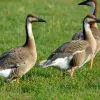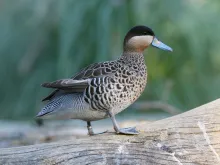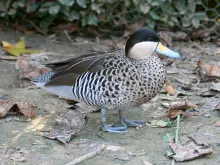
Silver Teal (Anas versicolor)
Species name
- Dutch name:
- Versicolortaling
- English name:
- Silver Teal
- German name:
- Versicolorente
- French name:
- Sarcelle bariolée
- Scientific name:
- Anas versicolor
Scientific classification
- Order:
- Anseriformes
- Family:
- Anatidae
- Onderfamilie:
- Anatinae
- Genus:
- Anas
Description
- Description:
Southern silver teal is bigger then the Northern silver teal.
Male:
Blackish-brown cap, Down to eye And nape, and thin line down back of neck Sharply demarcated from creamy-white cheeks and throat Lower neck, breast and anterior flanks buff with small blackish-brown spots, these becoming larger on flanks: Center of belly, vent and under tail-converts finely vermiculated grey. Mantle, Scapulars and back blackish brown with buff edgings; elongated tertails dark brown with very narrow pale edges; rump. Upper tail-converts and tail finely vermiculated grey. Speculum Bright iridescent green. with narrow white border in front, and narrow black then white borders behind, while upper wing converts slaty grey-blue. primaries and their converts dark brown. Under wing with white centre and dark leading edge, and grey flight feathers. broad and heavy Bill pale blue, with yellow spot behind and below nostrils. Black nail and black stripe down centre of upper mandible to tip. Legs and Feet dark grey.Female:
Smaller and duller overall; barring on flanks less distinct and tertails shorter, Speculum less bright green, as well as less extensive. Bill duller with little to no yellow at base.Juvenile:
Duller with less contrast on head, as crown browner and face tinged pale brown. more streaked then spotted and barred on under parts, speculum less iridescent green.
- Behaviour:
Silver teal (Anas versicolor) is well established in collections. Usually found as pairs or small groups, but sometimes larger flocks.
Sometimes found with other waterfowl species.
Standard Measurements
- Body Length (cm):
- The male (drake) of the Silver Teal measures approximately 38-43 centimeters. The female measures approximately 38-43 centimeters.
- Body Weight (grams):
- The male will weight about 370-440 gram. The female will weight about 370-440 gram.
The weight is notoriously variable and can only be used as indication!
- Subspecies:
There are two subspecies:
- Northern silver teal - S. versicolor versicolor (located in Paraguay, southern Bolivia, and southern Brazil).
- Southern silver teal - S. versicolor fretensis (located in southern Chile, Argentina, and the Falkland Islands).
- Note:
Dabbling Ducks are generally hardy, easy to maintain and easy to breed. Shelter may be required by some of the smaller species in winter. They should be provided with cover (including marginal pond cover) and loafing areas as well as water. A pen which is 50% water is suggested. The water may be shallow (i.e. no more than two feet deep is required), and muddy areas for dabbling in are also appreciated. These ducks are generally good in mixed collections, although the smaller and quieter species may be bullied. Territorial disputes between ducks of the same species may be avoided by keeping only one pair of each species in an enclosure, unless the area is very large. For a single pair of ducks a pen are of 50 to 100 square metres, depending on the size of duck, should be provided.
A diet based on wheat and pellets is suggested, with maintenance pellets changed to breeders pellets for the breeding season. Greenfood is also appreciated. Grit should always be available, with soluble grit (e.g. oystershell grit) as a calcium source when breeding.
Most species are ground nesters and both close ground cover and ground level nest boxes should be provided. Hand-rearing is generally preferred, as these ducks are generally poor parents in captive conditions, particularly in enclosures shared with other waterfowl. These ducks are prone to hybridization, particularly with closely related species, which should be kept apart from one another.
Silver teal (Versicolor teal) are relatively hardy, although frost-free shelter should be available in winter. They are suitable for mixed collections, although breeding may be improved in a separate enclosure. Good cover should be provided. Feed as other dabbling ducks (grain, pellets, grass).
These ducks are bred fairly easily - sporadically rather than commonly. Eggs may be laid from early or mid-April to June, in close ground cover or in nest boxes, and may be parent-incubated, but hand-rearing is suggested, providing good food. They may lay a second or even third clutch if eggs are removed.
Hybridisation uncommon, but reported with Puna teal (Anas puna) and at least once with Baikal teal (Anas formosa).
- Breeding:
- The female Silver Teal usually lays from 6-10 cream-white or pale pinkish eggs and incubates them for 25-27 days.
- Artificial incubating:
The ideal relative humidity for incubating most waterfowl eggs is 55% (ground nesters) and 40% (cavity nesters). The temperature is usually 37.4°C. Set ventilation as recommended by the incubator manufacturer. Eggs must be turned, either automatically or by hand, a minimum of 4 times a day. As the duckling develops there is a loss of water from the egg and the air sac gets bigger. In normal development of an egg with a 25-27 days incubation, the air sac occupies about a third of it three days earlier. Cleanliness is vital and ideally eggs should be moved to a separate hatcher at this point, where the humidity should be increased to 65% and even higher once they have pipped internally.
- Bird banding:
- Recommended closed leg band ring size for the Silver Teal is 8 mm.The leg band ring can only be applied on a young dabbling duck at around 10-12 days old.
- It doesn't matter what leg that you band, but it's good to have a consistent system. Suggested: Left leg = Female, Right leg = Male
- Maintenance food:
-





Lundi Regular with a protein content of 20%, valuable Spirulina and high-quality by-products is optimally balanced in its composition maintenance food for water ornamental fowl of all kinds. Especially green teal and Whistling ducks that are not dependent on a very high protein content, are well supplied.
Lundi Regular contains all the minerals and vitamins in full form that are important for the animals. Therefore also suitable as breeding food.

